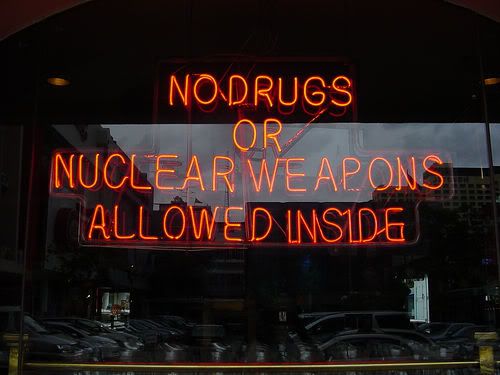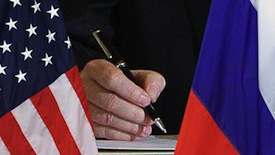New START Treaty Announced, Signing Slated for Prague
March 26, 2010
Featured Image
We are happy to serve you a daily summary of the day's top nuclear policy stories each morning, with excerpts from the stories in bullet form.
Stories we're following today:
Announcement of New START Treaty - Remarks of President Obama [link]
- I am pleased that almost one year to the day after my last trip to Prague, the Czech Republic – a close friend and ally of the United States – has agreed to host President Medvedev and me on April 8th, as we sign this historic Treaty.
- The new START Treaty cuts – by about a third – the nuclear weapons that the United States and Russia will deploy. It puts in place a strong and effective verification regime. And it maintains the flexibility that we need to protect and advance our national security.
- There is a long tradition of bipartisan leadership on arms control… my Administration will be consulting Senators from both parties as we prepare for what I hope will be strong, bipartisan support to ratify the new START treaty.
Key Facts About the New START Treaty - White House Press Release [link]
- Aggregate Limits:
- 1,550 warheads,
- 800 deployed and non-deployed launchers
- Verifications measures under the Treaty include on-site inspections and exhibitions, data exchanges and notifications related to strategic offensive arms and facilities covered by the Treaty, and provisions to facilitate the use of national technical means for treaty monitoring. To increase confidence and transparency, the Treaty also provides for the exchange of telemetry.
- The Treaty does not contain any constraints on testing, development or deployment of current or planned U.S. missile defense programs or current or planned United States long-range conventional strike capabilities.
Analysis: Treaty Advance's Obama's Nuclear Vision - New York Times [link]
- The arms control treaty being completed by the United States and Russia represents another step toward closing the books on the defining struggle of the final half of the 20th century. But it also marks the opening of a broader campaign to counter the emerging threats of the 21st century.
- If President Obama signs the treaty with President Dmitri A. Medvedev of Russia in Prague on April 8 as expected, it will give Mr. Obama a stronger hand heading into two back-to-back nuclear summit meetings where he wants to push toward the nuclear weapons-free world he envisions. At the two meetings, Mr. Obama hopes to forge international consensus to limit the spread of weapons and secure materials that could be vulnerable to terrorists, efforts that could be accelerated by the new treaty.
- “The larger meaning is the delegitimization of nuclear weapons,” said Kenneth N. Luongo, president of the Partnership for Global Security, a nonprofit group pushing for aggressive efforts at the approaching meetings. “Obama will be able to go, and Medvedev as well, and say, ‘Here’s what we did on disarmament. Now we need to get serious about nuclear terrorism and nuclear materials.’ ”
Lab Chiefs Share Nuke Safety Doubts - Politico [link]
- The directors of three national laboratories are warning that the unclassified version of a scientific report the Obama Administration released last year downplayed the risk and complexity involved in trying to maintain the nation’s nuclear arsenal without building newly-designed weapons systems or warheads.
- The publicly-released version of the JASON report found that the many changes to weapons over time to extend their lifespans did not present an increased risk and that the life of nuclear warheads could be extended for decades with no loss of confidence in the weapons' ability to work properly. According to the lab directors, those findings don't reflect the full story.
- Hans Kristensen of the Federation of American Scientists said, "The Obama administration and Congress need to hold [the lab directors] to the fire when they argue for modifications of warheads. Otherwise we will see an incremental creep toward new warheads via additional safety and security features."
A View from the Dark Side
Time for an Electromagnetic Pulse (EMP) Attack Recognition Day - The Heritage Foundation [link]
- On March 23, 1983, President Ronald Reagan gave a famous speech where he outlined his plans for the Strategic Defense Initiative (SDI), aimed at protecting America from a nuclear missile attack using land- and sea-based missile defense systems. On the anniversary of this famous oratory, however, America faces another threat, one that requires Congress’s immediate attention: an electromagnetic pulse (EMP) attack.
- In order to facilitate a national discussion regarding the EMP threat, Congress should establish March 23 as EMP Recognition Day.
- Nod to Wired's Danger Room
The Lighter Side

Nod to Nukes of Hazard



